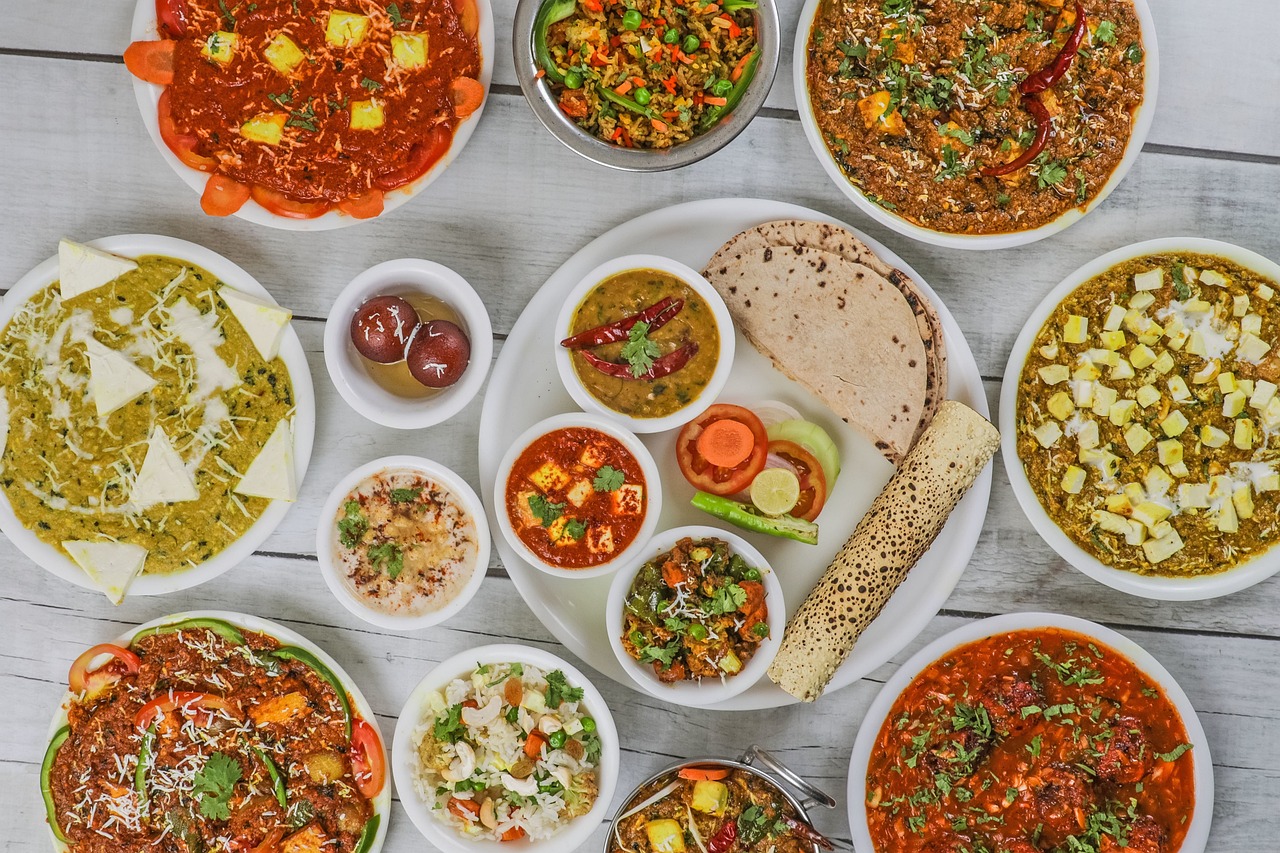Nourishing Winter Foods: Embrace the Season with Healthy Indian Delicacies

Healthy Winter Foods in India: Nourish Your Body with Seasonal Delights
As winter sets in, the colder temperatures bring with them a host of health challenges, such as a dip in immunity, dry skin, and a general feeling of lethargy. During this season, it’s essential to nourish the body with foods that not only provide warmth but also fortify our immune system, improve digestion, and keep us energized throughout the day. In India, winter is a time to indulge in rich, nutrient-packed seasonal foods, many of which are deeply rooted in cultural traditions and culinary practices. This blog explores the top healthy winter foods in India, highlighting dishes like Sarson ka Saag, Gajar ka Halwa, and more, to help you stay healthy, warm, and nourished during the chilly months.
1. Sarson ka Saag and Makki di Roti
One of the most iconic winter dishes in North India, especially in the states of Punjab and Haryana, Sarson ka Saag is a hearty, nutritious preparation made from mustard greens. Rich in vitamins A, C, and K, mustard greens are packed with antioxidants and are known to have anti-inflammatory properties, which can help boost immunity during the cold months. The saag is usually cooked with spices, ginger, garlic, and a dollop of ghee, making it not just nutritious but also flavorful and warming.
The saag is traditionally paired with Makki di Roti, a flatbread made from cornmeal. This combination offers a wholesome meal that is rich in carbohydrates, providing the energy needed to combat the winter chill. Both Sarson ka Saag and Makki di Roti are known for their ability to boost digestion, prevent cold-related ailments, and promote overall well-being. This dish is particularly ideal during the winter months as mustard greens are at their peak during this season.
2. Gajar ka Halwa
No list of winter foods in India is complete without mentioning Gajar ka Halwa, a beloved dessert that has stood the test of time. This warm, sweet dish is made from grated carrots, which are abundant during the winter season. Carrots are a great source of beta-carotene, which the body converts into vitamin A, essential for maintaining healthy vision, skin, and boosting immunity.
The addition of ghee, cardamom, and sugar enhances the dish's flavor while providing energy and warmth. Gajar ka Halwa is also a good source of fiber, which aids in digestion, and the antioxidants in carrots help in fighting free radicals that cause inflammation. This dish not only satisfies your sweet tooth but also provides you with essential nutrients to stay energized and healthy throughout the colder months.
3. Mooli (Radish)
Radishes, or mooli, are another winter vegetable that deserves a place in your diet. Packed with vitamin C, fiber, and antioxidants, mooli is known for its ability to support digestion and improve skin health, which can often become dry and dull during the winter months. The presence of sulfur compounds in radish helps detoxify the body and maintain a healthy liver.
Mooli is commonly used in salads, parathas (stuffed flatbreads), and even soups, providing both taste and health benefits. Mooli paratha is a popular dish in many Indian households during winter, served with yogurt or pickle to balance the spicy flavors. Eating mooli regularly during the winter months can help in maintaining a healthy digestive system, reducing bloating, and fighting colds and flu.
4. Undhiyu
Undhiyu is a classic winter dish from Gujarat, made using a mix of seasonal vegetables like sweet potatoes, surti papdi (flat beans), eggplant, and raw bananas. It’s cooked with a blend of traditional spices and fresh fenugreek leaves, which add a unique flavor and health benefits. The dish is typically prepared by slow-cooking the vegetables, which helps retain their nutrients and flavors.
The seasonal vegetables in Undhiyu are rich in fiber, vitamins, and minerals, which support digestive health, boost immunity, and provide energy. The use of fenugreek leaves is particularly beneficial during the winter months, as it helps in maintaining healthy blood sugar levels and combats inflammation. Undhiyu is typically enjoyed with rotis or rice, making it a wholesome, satisfying meal for a chilly winter evening.
5. Pap (Chikkis) and Til (Sesame)
Winter in India is also synonymous with an array of sweets made with sesame seeds, jaggery, and peanuts. Til or sesame seeds are packed with calcium, iron, and magnesium, all of which are vital for maintaining strong bones, improving blood circulation, and boosting overall health. In many parts of India, especially in Maharashtra and Gujarat, people indulge in til chikki, a crunchy, sweet treat made from sesame seeds and jaggery, during the winter months.
Jaggery, a traditional sweetener, is known for its ability to boost energy, improve digestion, and cleanse the body by flushing out toxins. The combination of sesame and jaggery in winter foods not only provides warmth but also strengthens the immune system, helping to fight off winter ailments like colds and flu.
6. Sweet Potatoes
Sweet potatoes, a staple in winter cuisine across India, are loaded with vitamins A and C, potassium, and fiber. They are a rich source of antioxidants and help maintain stable blood sugar levels. Sweet potatoes are commonly roasted, boiled, or used in curries and soups during the winter months. They are filling, warm, and incredibly versatile in the kitchen.
A simple dish of roasted sweet potatoes seasoned with salt and pepper makes for a healthy snack, while sweet potato chaat or curry can be a delightful addition to your meals. Eating sweet potatoes during winter helps maintain energy levels, supports digestive health, and nourishes the skin from within.
7. Pongal
Pongal, a comforting dish made from rice and lentils, is a popular winter breakfast in South India. The dish is typically seasoned with black pepper, cumin, ginger, and ghee, making it a warming, nourishing meal to start the day. It’s an excellent source of protein, fiber, and essential vitamins, thanks to the combination of rice and lentils.
Pongal is not just filling but also a good source of energy, making it ideal for the cold mornings of winter. The spices in the dish, particularly black pepper and ginger, have warming properties that help to regulate body temperature and prevent colds. The addition of ghee adds healthy fats, which are essential for maintaining overall health during the winter months.
8. Kale and Spinach
Leafy greens like kale and spinach are essential winter vegetables that should not be overlooked. These greens are rich in vitamins A, C, and K, and are packed with antioxidants and fiber. Kale is particularly known for its high levels of vitamin K, which is essential for bone health and blood clotting. Spinach, on the other hand, is rich in iron, which helps to combat fatigue and weakness often associated with colder months.
These greens can be incorporated into various dishes like saag, soups, stews, or stir-fries. Regular consumption of kale and spinach helps to boost immunity, promote digestive health, and prevent anemia, which can be more common during the winter months.
Conclusion: Savor the Season’s Bounty
Winter in India offers a rich variety of seasonal foods that not only tantalize the taste buds but also provide numerous health benefits. From the earthy flavors of Sarson ka Saag to the sweet comfort of Gajar ka Halwa, these dishes are deeply connected to India’s culinary heritage and play a significant role in maintaining our health and well-being during the colder months.
By incorporating these nutrient-dense winter foods into your diet, you can ensure that your body stays energized, your immunity stays strong, and your skin remains radiant despite the chill. So, embrace the season’s bounty and enjoy these wholesome, traditional foods that nourish both body and soul!
Posted By: Ashish kumar
.gif)
.gif)





%20(600%20%C3%97%20450px)%20(600%20%C3%97%20360px)%20(500%20%C3%97%20300px)%20(448%20%C3%97%20300px).jpeg)
.jpeg)
%20(800%20%C3%97%20450px).jpeg)
%20(509%20%C3%97%20336px)%20(528%20%C3%97%20264px).jpeg)